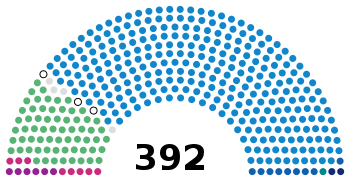1879 Spanish general election
The 1879 Spanish general election was held on Sunday, 20 April and on Saturday, 3 May 1879, to elect the 1st Restoration Cortes of the Kingdom of Spain. All 392 seats in the Congress of Deputies were up for election, as well as 180 of 360 seats in the Senate.[1]
| |||||||||||||||||||||||||||||||||||||||||||||||||||||||||||||
All 392 seats in the Congress of Deputies and 180 (of 360) seats in the Senate 197 seats needed for a majority in the Congress of Deputies | |||||||||||||||||||||||||||||||||||||||||||||||||||||||||||||
|---|---|---|---|---|---|---|---|---|---|---|---|---|---|---|---|---|---|---|---|---|---|---|---|---|---|---|---|---|---|---|---|---|---|---|---|---|---|---|---|---|---|---|---|---|---|---|---|---|---|---|---|---|---|---|---|---|---|---|---|---|---|
| |||||||||||||||||||||||||||||||||||||||||||||||||||||||||||||
| |||||||||||||||||||||||||||||||||||||||||||||||||||||||||||||
This was the first election held under the Spanish Constitution of 1876 and the new electoral law of 1878, which re-established censitary suffrage.
Overview
Background
The Spanish Constitution of 1876 enshrined Spain as a constitutional monarchy, awarding the King power to name senators and to revoke laws, as well as the title of commander-in-chief of the army. The King would also play a key role in the system of the turno pacífico (English: Peaceful Turn) by appointing and toppling governments and allowing the opposition to take power. Under this system, the Conservative and Liberal parties alternated in power by means of election rigging, which they achieved through the encasillado, using the links between the Ministry of Governance, the provincial civil governors, and the local bosses (caciques) to ensure victory and exclude minor parties from the power sharing.
Electoral system
The Spanish Cortes were envisaged as "co-legislative bodies", based on a nearly perfect bicameralism. Both the Congress of Deputies and the Senate had legislative, control and budgetary functions, sharing equal powers except for laws on contributions or public credit, where the Congress had preeminence.[2][3] Voting for the Cortes was on the basis of censitary suffrage, which comprised national males over twenty-five, being taxpayers with a minimum quota of twenty-five pesetas per territorial contribution or fifty per industrial subsidy, as well as being enrolled in the so-called capacity census (either by criteria of Education or for professional reasons).[4]
For the Congress of Deputies, 88 seats were elected using a partial block voting in 26 multi-member constituencies, with the remaining 304 being elected under a one-round first-past-the-post system in single-member districts. Candidates winning a plurality in each constituency were elected. In constituencies electing eight seats, electors could vote for up to six candidates; in those with seven seats, for up to five candidates; in those with six seats, for up to four; in those with four or five seats, for up to three candidates; and for one candidate in single-member districts. Additionally, up to ten deputies could be elected through cumulative voting in several single-member constituencies, provided that they obtained more than 10,000 votes overall. The Congress was entitled to one member per each 50,000 inhabitants, with each multi-member constituency being allocated a fixed number of seats: 8 for Madrid, 5 for Barcelona and Palma, 4 for Seville and 3 for Alicante, Almería, Badajoz, Burgos, Cádiz, Cartagena, Córdoba, Granada, Jaén, Jerez de la Frontera, La Coruña, Lugo, Málaga, Murcia, Oviedo, Pamplona, Santa Cruz de Tenerife, Santander, Tarragona, Valencia, Valladolid and Zaragoza. The law also provided for by-elections to fill seats vacated throughout the legislature.[2][5][lower-alpha 3]
For the Senate, 180 seats were indirectly elected, with electors voting for delegates instead of senators. Elected delegates—equivalent in number to one-sixth of the councillors in each municipal corporation—would then vote for senators using a write-in, two-round majority voting system. The provinces of Álava, Albacete, Ávila, Biscay, the Canary Islands, Cuenca, Guadalajara, Guipúzcoa, Huelva, Logroño, Matanzas, Palencia, Pinar del Río, Puerto Príncipe, Santa Clara, Santander, Santiago de Cuba, Segovia, Soria, Teruel and Valladolid were allocated two seats each, whereas each of the remaining provinces was allocated three seats, for a total of 147. The remaining 33 were allocated to a number of institutions, electing one seat each—the Archdioceses of Burgos, Granada, Santiago de Compostela, Santiago de Cuba, Seville, Tarragona, Toledo, Valencia, Valladolid and Zaragoza; the Royal Spanish Academy; the Royal Academies of History, Fine Arts, Sciences, Moral and Political Sciences and Medicine; the Universities of Madrid, Barcelona, Granada, Havana, Oviedo, Salamanca, Santiago, Seville, Valencia, Valladolid and Zaragoza; and the Economic Societies of Friends of the Country from Madrid, Barcelona, Cuba–Puerto Rico, León, Seville and Valencia. An additional 180 seats comprised senators in their own right—the Monarch's offspring and the heir apparent once coming of age; Grandees of Spain of the first class; Captain Generals of the Army and the Navy Admiral; the Patriarch of the Indies and archbishops; as well as other high-ranking state figures—and senators for life (who were appointed by the Monarch).[6][8]
Election date
The term of each House of the Cortes—the Congress and one-half of the elective part of the Senate—expired five years from the date of their previous election, unless they were dissolved earlier. The Monarch had the prerogative to dissolve both Houses at any given time—either jointly or separately—and call a snap election.[2][5][6]
Results
Congress of Deputies
 | ||||
| Parties and coalitions | Seats | |||
|---|---|---|---|---|
| Seats | +/− | |||
| Liberal Conservative Party (Ministerials) (PLC) | 295 | –18 | ||
| Foralist Conservatives (Cons.f) | 2 | –6 | ||
| Moderate Party (PM) | 9 | –3 | ||
| Total Conservatives | 304 | –21 | ||
| Constitutional Party (PC) | 64 | +12 | ||
| Foralist Liberals (Lib.f) | 0 | –2 | ||
| Democratic Progressive Party (PPD)1 | 8 | +2 | ||
| Democratic Party (PD)2 | 6 | +5 | ||
| Total Liberal–Progressive alliance | 78 | +19 | ||
| Independent Ultramoderates (U) | 2 | +2 | ||
| Foralist Catholics (Cató.f) | 1 | +1 | ||
| Total Carlists and Catholics | 2 | +2 | ||
| Basque Union (UV) | 1 | +1 | ||
| Independents (Indep) | 4 | –3 | ||
| Vacants | 3 | +3 | ||
| Total | 392 | +1 | ||
| Sources[9][10] | ||||
Notes
- Aggregated data for PDR and Rad.m in the 1876 election.
- Data for PRDF in the 1876 election.
- Amendments in the electoral law throughout 1877 had seen the approval of separate laws for both chambers, with a modified version of the 1865 electoral law being provisionally reinstated for the Congress until a final, definitive law was approved in 1878.[5][6][7]
Bibliography
- Carreras de Odriozola, Albert; Tafunell Sambola, Xavier (2005) [1989]. Estadísticas históricas de España, siglos XIX-XX (PDF) (in Spanish). Volume 1 (II ed.). Bilbao: Fundación BBVA. pp. 1072–1097. ISBN 84-96515-00-1. Archived from the original (PDF) on 24 September 2015.
References
- "Royal decree declaring dissolved the Congress of Deputies and the elective part of the Senate". Royal Decree of 10 March 1879 (PDF). Gazette of Madrid (in Spanish). Retrieved 27 December 2016.
- "Spanish Constitution of 1876". Act of 30 June 1876 (PDF). Gazette of Madrid (in Spanish). Retrieved 27 December 2016.
- "El Senado en la historia constitucional española". senado.es (in Spanish). Senate of Spain. Retrieved 26 December 2016.
- Carreras de Odriozola & Tafunell Sambola 2005, pp. 1077.
- "Electoral Law for Deputies to Cortes of 1878". Electoral Law of 28 December 1878 (PDF). Gazette of Madrid (in Spanish). Retrieved 27 December 2016.
- "Electoral Law for Senators of 1877". Electoral Law of 8 February 1877 (PDF). Gazette of Madrid (in Spanish). Retrieved 27 December 2016.
- "Electoral Law for Deputies to Cortes of 1877". Electoral Law of 20 July 1877 (PDF). Gazette of Madrid (in Spanish). Retrieved 27 December 2016.
- "Law setting up rules for the election of Senators in the islands of Cuba and Puerto Rico of 1879". Law of 9 January 1879 (PDF). Gazette of Madrid (in Spanish). Retrieved 27 December 2016.
- "Cortes election 20 April 1879". historiaelectoral.com (in Spanish). Electoral History. Retrieved 24 September 2017.
- "Graphs and analysis: Elections in the Revolutionary Sexennium and the Restoration 1869-1923". historiaelectoral.com (in Spanish). Electoral History. Retrieved 24 September 2017.
External links
- Historical archive of deputies (1810–1977) from www.congreso.es, the official Congress of Deputies web portal (in Spanish)
- Elections in the Sexenio Revolucionario and the Restoration at www.historiaelectoral.com (in Spanish/Catalan)
.png)
.jpg)
.jpg)

.jpg)